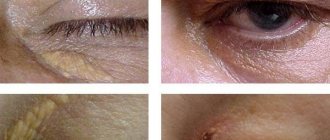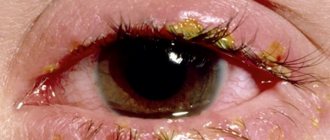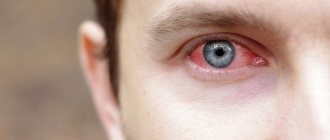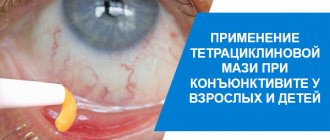General information
The causative agents of this type of allergy are usually environmental factors - due to the characteristics of the skin around the eyes, allergens easily penetrate inside. The reaction appears after 10-15 minutes.
Allergies can also be triggered by taking medications or eating certain foods. If an allergen is ingested orally, the body can react no earlier than after 3-4 hours.
Forms and types
The variety of types of eyelid dermatitis is determined by the numerous forms of manifestation and types of irritant. It is necessary to establish the type of disease in this particular case, since the treatment regimen and tactics will depend on this. How are they different?
Allergic
Allergic dermatitis of the eyelids is more common than others. In most cases, this type of dermatitis is of a contact nature. The face is the exposed part of the human body. She is exposed to the external environment more than others. With a sufficient degree of sensitization (sensitivity) of the body, sunlight, plant pollen, chemicals, and cosmetics can cause an allergic reaction.
Even short contact with the thin skin of the eyelids is enough for the allergen to penetrate into the inner layers and cause an immediate reaction. With this type of exposure, the first signs appear within 10 minutes and disappear within 2 hours after contact is eliminated. If the allergen is ingested orally, the onset of the disease will be delayed by 3-4 hours - a long-term reaction. It continues for several days or weeks after the end of the stimulus.
| Photographs of manifestations of allergic dermatitis on the skin of the eyelids |
Provoking factors for allergic dermatitis are hereditary predisposition, low immunity, and frequent stress.
The main symptoms are severe eye swelling, redness, and a vesicular or bullous rash. The corners of the eyes are swollen. A severe case is Quincke's edema, spreading to neighboring areas. Atopic dermatitis is diagnosed by the presence of the Denny-Morgan sign (an additional fold of the lower eyelid).
This type is treated by eliminating the allergen from the body, as well as neutralizing its effect with the help of antihistamines. Detoxification therapy will also be useful.
Infectious
In the herpetic form of dermatitis, the reaction of the eyelids is due to the ability of the virus to penetrate the thickness of the skin and have a dermatotropic effect (direct effect on the skin). If the cause is another infection (measles, scarlet fever, chickenpox), then the reason lies in the addition of a secondary infection, or an allergy to the medications taken. Provoking factors for infectious dermatitis of the eyelids are decreased immunity during the disease process and hereditary predisposition.
| Dermatitis caused by infection |
The main sign of herpes in the eyes is the appearance of watery blisters with crusts, which are not recommended to be disturbed until they disappear completely. This form is characterized by a deterioration in the general condition of the patient with intoxication and a rise in temperature. The disease is characterized by a recurrent course and may be complicated by involvement of the nasociliary nerve and damage to the cornea.
The main method of treatment is a course of antiviral drugs, maintaining the body’s defenses.
Seborrheic
Seborrheic dermatitis is a consequence of dysfunction of the facial sebaceous glands, which occurs as a result of hormonal imbalance. Provoking factors are endocrine pathologies, age-related changes, stress.
The immediate cause of the disorder is the pathological activity of the Malassezia fungus, which lives on the surface of the skin, rich in sebaceous glands. The fungus stimulates the production of sebaceous secretions, so the affected areas have an oily sheen. The affected area is the ciliary edge of the eyelids. It becomes inflamed, crusts over, and causes peeling and itchy red spots in the surrounding areas. Eyelashes fall out and their growth is disrupted. The skin on the cheeks, nose, and around the mouth may be involved.
| Seborrhea |
The main method of treating seborrheic dermatitis is taking antifungal drugs, treating the eyes with antiseptics and fucarcin solution. Triderm ointment, which has an antifungal and anti-inflammatory effect, is very helpful in these cases.
Medication
Drug dermatitis is a consequence of the body’s individual reaction to the use of medications for the treatment of inflammatory and infectious eye diseases. Intolerance to these drugs causes a side reaction in the form of acute inflammation. Eye drops usually lead to damage to the inner corners of the eyes, while ointments negatively affect the condition of the conjunctiva.
| Caused by medication |
Medications can cause a rapid allergic reaction. As a result, the color of the dermis changes, the local temperature rises, swelling and discharge from the eyes appear. The main method of treatment is the abolition of drugs that cause a negative reaction.
Eczematous
Eczematous dermatitis of the eyelids is a rare form. It affects young children during long-term treatment of bacterial eye infections with potent ophthalmic ointments based on antibiotics and sulfonamides. Long-term physiotherapy based on electrophoresis is also a provocateur. The disease is a symptom of helminthiasis, dysfunction of the gastrointestinal tract.
As its name suggests, the symptoms of this form of dermatitis are similar to those of ocular eczema. The disease begins with redness of the eyelids and swelling. Then rashes appear in the form of vesicles. The main distinguishing feature of the eczematous form is pain that causes severe discomfort.
What can trigger an attack
Any allergic reaction develops against the background of decreased immunity to the effects of certain substances. Often, a predisposition to allergies is transmitted at the gene level or is a consequence of previous diseases with long-term treatment. At the same time, the list of what can “trigger” the process and, in particular, cause eyelid dermatitis is quite wide.
The most common irritants that provoke redness of the eyelid increasingly include:
- All kinds of cosmetics. The risk is especially high when using low-quality decorative cosmetics.
- All types of citrus fruits, nuts, chicken eggs, strawberries, many seafood, milk and a number of other foods.
- A microscopic mite that parasitizes the skin of the face. It is noteworthy that these microorganisms can be transferred through the use of the same glasses or cosmetics by several people.
- Incorrectly fitted contact lenses. Thus, an inflammatory reaction can occur as a result of an incorrectly chosen size of optical, cosmetic or decorative lenses, or if the body has not “accepted” the material from which they are made.
- Chemicals added to cleaning products and detergents and used in the chemical or pharmaceutical industries.
- All kinds of medicines. At the same time, both topical agents (drops and ointments) and those taken orally can be equally allergenic.
- The smallest particles of animal skin, feathers or saliva.
- Household or book dust, especially when there is a large accumulation of it.
- Pollen.
- Mold.
- Cold. Especially in windy weather.
It is worth noting that sometimes allergies on the eyelids can occur when using ordinary water. This happens if it contains a large amount of substances that are potential allergens.
Treatment methods
Treatment of eyelid dermatitis is prescribed after identifying its true cause. This will determine the tactics, which first take into account the provoking factors, and only then the symptoms.
For contact forms of dermatitis, it is important to block the action of the irritant. This is often enough to eliminate the painful reaction. Protecting the eyelid area from environmental influences and eliminating allergenic cosmetics and medications is the most important therapeutic measure. This is followed by stopping the body’s reaction to the stimulus.
Dermatitis on the skin is defeated!
A natural product without any chemicals or danger to the skin. Just remember to apply twice a day….
>
- Treatment of allergic dermatitis. The main thing is the use of antihistamines, which help suppress the release of histamine. They relieve painful symptoms, causing the well-being and mood of patients to significantly improve (Erius, Loratadine). Non-steroidal anti-inflammatory drugs relieve residual effects of allergies and stop the inflammatory process. Local preparations (Indomethacin, Ortofen ointments) are used more often.
- Treatment of the herpetic form of dermatitis begins with the use of an antiviral ointment based on acyclovir. It is applied to the areas affected by the rash when the first symptoms appear. Treatment is intensified with detoxification therapy to cleanse the blood of virus waste products. After normalization of the patient's condition, administration of a herpetic vaccine is recommended. This will help prolong remission and strengthen the body's defenses.
- Treatment of the seborrheic form consists of the use of antifungal agents (Ketorol, Nizoral, Lamisil), hormonal emulsions to relieve inflammation. As an auxiliary therapy, it is recommended to take compounds to enhance immunity. It is necessary to carefully observe eyelid hygiene.
| The result of treatment with combination drugs in 12 days |
For any form of eyelid dermatitis, auxiliary therapy is used to promote effective treatment. The main methods are:
- Taking sedatives helps to gain the mental balance necessary for successful treatment of the disease (leonwort tincture, Novopassit, glycine).
- Restoring intestinal microflora helps support immunity. When treating eczematous dermatitis, stabilization of the gastrointestinal tract is a prerequisite.
- Prevention of the development of secondary infection in severe forms of dermatitis, fraught with infectious complications. Treat the areas around the eyes with antiseptics (tinctures of chamomile, oak bark, furatsilin solution, potassium permanganate).
Forms of allergies and their features
According to the classification, there are several forms of eyelid allergies. They are all very similar in their symptoms, but may have a number of differences. Among the most typical:
- Dermatitis on the eyelids . Most often it is a “response” to excessive or improper use of cosmetics. But it can also occur when using certain types of medications (especially with a long course of drug therapy). This form directly affects the eyelids and is characterized by swelling and redness with a gradual increase in itching and burning.
- Psoriasis on the eyelids . Psoriasis can affect only one eyelid or spread to both. One of its distinguishing features is severe peeling.
- Keratoconjunctivitis . A variety of factors can provoke this type of disease: from infections to contact lenses. As a rule, it affects the conjunctiva and cornea of the eye, but its “echoes” also appear on the eyelids. Microscopic formations near the eyelashes allow this form to be distinguished from others.
- Hay conjunctivitis , which occurs due to intolerance to substances contained in the pollen of certain flowers and plants. A characteristic symptom is a rash on the eyelids, accompanied by itching.
- Eczema of the eyelids . A pathology that manifests itself in several parts of the body at once. Like other types of allergies, eyelid eczema can be the result of exposure to an allergen. But this form can also be caused by psychological factors, which include strong emotions and experiences, nervous shocks and a number of others.
Important! Regardless of the form of allergy and its symptoms, it requires immediate treatment! With incorrect or untimely treatment, any type of disease can become chronic and cause its “owner” many unpleasant moments in the future.
Dermatitis on the eyelids in an adult
Psoriasis on the eyelids
Eczema on the upper eyelid
How does herpes appear in the eyelid area?
Herpes of the upper eyelid, as a rule, is represented by a series of blisters that extends from the corner to the middle of the eyelid. In most cases, the rash starts from the inner corner of the eye, near the bridge of the nose and spreads towards the middle.
Uncomplicated ophthalmoherpes occurs exclusively on the skin of the upper or lower eyelid.
On the lower eyelid, herpes rashes can be located chaotically. However, quite often they are located near the inner corner of the eye. Without appropriate treatment, herpetic blisters can very quickly spread to the inner surface of the eye and cause the appearance of specific conjunctivitis, iritis, and iridocyclitis.
The occurrence of symptoms depends largely on the type of virus that causes the disease.
Herpes simplex virus
Infection occurs through contact - particles of the virus are transmitted from person to person. The first signs of the disease are associated with the general reactions of the body. This:
- malaise;
- general weakness;
- pain in the head area;
- increase in body temperature.
Then more specific symptoms appear - redness of the skin of the eyelids and face. Quite quickly, bubbles appear filled with liquid, which becomes cloudy. The rashes are located on both the lower and upper eyelids. The blisters gradually dry out and crusts form, which disappear within a few weeks, leaving no scars. Pigment spots may persist for some time, which then also disappear.
A differential diagnosis should be made between molluscum contagiosum and syphilitic lesions.
Herpes virus type 3 - herpes zoster
After entering the body, the virus multiplies for some time. When local immunity decreases, it becomes more active. The virus can affect people of all ages, however, rashes in the eyelid area are most common in adults aged 30-40 years and 60-70.
The lesion is localized mainly in the upper eyelid - along the superior branch of the trigeminal nerve. However, the rash can also appear on the lower eyelid if the middle branch is involved.
First, small pink spots appear, which after a few days rise above the surface of the skin and are filled with liquid contents. Throughout the entire illness, intense pain syndrome is expressed.
This variant of the disease, after treatment, is characterized by a decrease in the sensitivity of the affected area and the development of postherpetic neuralgia.
Symptoms
Despite the wide variety of forms of manifestation, any allergy on the eyelids has a number of similar symptoms. The most striking and typical of them are:
- severe itching sensation;
- burning;
- hyperemia of the skin of the eyelids;
- swelling;
- increased photosensitivity;
- the appearance of spots or peeling of the epidermis.
In some cases, these symptoms may additionally be accompanied by increased activity of the lacrimal glands and increased intraocular pressure.
Diagnostics
Despite similar symptoms, different forms of the disease may require different treatments. Therefore, before starting treatment, it is necessary to make the diagnosis as accurately as possible. This can only be done by a specialist, and only on the basis of a series of laboratory tests.
In the process of making a diagnosis, you may need the help of an allergist, ophthalmologist and otolaryngologist.
When contacting, any doctor begins making a diagnosis by collecting an anamnesis. After this, if necessary, he prescribes laboratory tests:
- blood;
- tear fluid;
- tissues taken as a result of scraping from the cornea.
These tests make it possible not only to determine the amount of allergen in the body, but also to determine its type, which greatly simplifies further treatment.
Possible complications
With the right treatment, herpes types 1 and 2 practically do not cause complications. But when exposed to Herpes Zoster, even adequate drug therapy cannot prevent the spread of infection.
The most common conditions that develop are:
- Eversion or deformation of the eyelid.
- Trichiasis is an abnormal growth of eyelashes when they are directed not outward, but inward - towards the eyeball.
- Keratitis is an inflammatory lesion of the cornea of the eye.
- Retinal vascular thrombosis.
- Herpetic conjunctivitis is a lesion of the mucous membrane of the eye.
- Paresis of the orbital nerves – quite often oculomotor.
- Iritis is inflammation of the iris.
- Retrobulbar neuritis.
If any complications develop, further treatment is carried out in a hospital setting.
Even after successful treatment, with an infectious lesion of Herpes Zoster, pain along the branches of the trigeminal nerve may persist for several months.
First aid
As a rule, allergies on the eyelids begin abruptly and always at the wrong time. At the same time, it can be quite difficult to see a doctor at the first symptoms. However, it is also impossible to leave it “as is” until you can get an appointment with a specialist - it is necessary to urgently take measures to reduce the severity of the reaction.
The very first action when an allergy develops should be to stop contact with the allergen. And when the latter is not known for certain - with potentially the most dangerous substances. To reduce symptoms, take an antihistamine as quickly as possible.
Also, as part of first aid, you need to wash your face, removing all makeup from it. You cannot use any special means for this, which under some circumstances can only intensify the reaction.
You can quickly get rid of redness and swelling with the help of cool compresses. The simplest option is cotton pads soaked in water and placed briefly in the refrigerator. Instead of water, it is allowed to use decoctions of medicinal herbs, in particular chamomile and calendula. Thanks to the anti-inflammatory and bactericidal substances they contain, they gently and effectively eliminate most unpleasant symptoms. You can also use regular strong tea leaves (you can use tea bags). True, when using tea and herbs, you need to be 100% sure that they themselves cannot cause allergies.
Drinking plenty of fluids will also help relieve eyelid dermatitis (it is best to use plain water for this). Entering the body, water will help speed up the process of removing harmful substances. Activated carbon, which is one of the best sorbents, will help enhance the process of removing toxins.
Thanks to all these measures, it is possible to quickly reduce allergic manifestations. However, all of them provide only a temporary effect, therefore, as soon as the patient feels a little better, it is necessary to seek professional advice.
Important! If, in addition to allergy symptoms, you experience choking or difficulty breathing, you should call an ambulance. It is possible that these symptoms are signs of anaphylactic shock , which can be fatal.
Treatment methods
There are several treatment options that can be combined. The general rules for all types of treatment are to avoid contact with the allergen. In addition, you must refrain from using any cosmetics and strictly adhere to the medication schedule prescribed by your doctor.
Drug therapy
This treatment method uses systemic and local antiallergic drugs.
Suprastin, Diazolin or Diphenhydramine are excellent as first aid. Subsequently, in accordance with the doctor’s prescription, they drink Loratadine, Claritin, Telfast, Zyrtec and similar systemic antihistamines.
Local medications include various drops designed to eliminate itching, redness and swelling. Such drugs include Allergodil, Ketotifen, Alomide and others.
Particularly recommended drugs include:
- Faurine balm is based on herbal ingredients that gently relieve inflammation and itching and do not cause side effects.
- Azelastine is a drop suitable for the treatment of acute allergic conjunctivitis and acts almost instantly, which plays an important role in severe inflammatory processes.
- Lecrolin - help to quickly get rid of not only itching and burning, but also reduce the sensitivity of the organs of vision to bright light.
- Opatanol - drops that are good for conjunctivitis and keratitis.
Along with activated carbon, Polysorb or Filtrum can be used as energy sorbents.
Treatment with ointments
Various ointments with hormones can speed up the regeneration of the skin around the eyes, quickly relieve inflammation and eliminate other allergy symptoms.
Among the most common and effective ointments with hormones are:
- Dexamethasone. According to the instructions, this ointment is placed behind the lower eyelid in a thin strip. At the same time, during application of the ointment, the tube should not be allowed to come into contact with the mucous membrane and other surfaces of the eye in order to prevent infection of its contents. The duration of use of the product is no more than 3 weeks.
- Hydrocortisone. This drug relieves swelling well and reduces redness. Used with the same precautions as the previous drug.
Also, the most popular ointments include Lorinden, Advantan, Celestoderm and a number of others.
At the very beginning of treatment, these ointments are applied to the area around the eyes up to 5-6 times a day. And after the swelling and redness subside a little, the frequency of use is reduced to twice a day.
Important! All ointments with added hormones are prescribed exclusively by a doctor and are used for a short time.
If the allergic reaction is not very severe, then you can also use non-hormonal ointments, such as Bepanten, Actovegin, Fucidin and others.
Treatment with folk remedies
The most effective and popular folk remedies are compresses and lotions that relieve itching, burning and help cope with swelling.
In addition to lotions made from herbal decoctions, which are recommended when the first signs of allergy appear, traditional medicine also advises using fresh potatoes, cucumbers or apples. For that. To prepare a healing potion from them, you need to thoroughly wash the fruit and grate it. After this, the prepared pulp is placed on gauze and a compress is applied to the eyes for 15-20 minutes. Repeat the procedure up to 3 times a day.
You can also use a combination of vegetables and fruits to make purees.
Another effective remedy is a mixture of finely chopped onions and honey. To prepare the mixture, use one medium-sized onion and a tablespoon of honey. After mixing the ingredients, boil them for 5 minutes, then cool, spread on gauze and apply to the eyelids for 20-30 minutes.
Kalanchoe juice is also considered a good remedy for relieving swelling and itching. You should also soak a cotton pad in the juice squeezed from the leaves of the plant and wipe the inflamed eye(s) with it.
No less effective in combating an allergic reaction is a tincture of dill seeds, for the preparation of which the seeds are brewed with a glass of boiling water for 15 minutes, after which they are strained and used to wash the eyelids. Dill can be replaced with dried parsley. It is also poured with boiling water for 15 minutes, strained and used to wash the eyes.
Fresh birch sap also helps relieve inflammation. To reduce redness, apply a cotton swab dipped in birch sap to your eyes. The procedure time is 2-3 minutes.
In addition, washing the eyes with a soda solution, which is prepared using ordinary baking soda dissolved in water, helps reduce inflammation.
People have long used the healing properties of rye bread. Applying it to the eyes also helps reduce redness and swelling. However, before applying the bread to your eyes, place it in the refrigerator for a couple of hours.
Regular vegetable oil also helps relieve irritation. For these purposes, you can use sunflower, fir, olive, flaxseed and others (the main condition is that it should be as natural as possible, not refined).
Is there a danger and can there be complications?
The danger of complications exists in the absence of adequate treatment and progression of the inflammatory process. Complications usually occur at the stage of vesicular rashes. Small bubbles gradually open, compromising the integrity of the skin. When scratched, these areas become infected, opening the gates to bacterial flora and the development of inflammatory eye diseases - conjunctivitis, blepharitis, keratitis.
Pharmacies hid it!
Even “advanced” dermatitis can be cured at home. Just remember to apply twice a day….
>
Important! Symptoms such as damage to the conjunctiva, redness of the eyes, sharp pain, inflammation of the lacrimal sac indicate that powerful local and general antibacterial therapy cannot be avoided. The most dangerous complication of periorbital dermatitis is abscess and phlegmon of the eyelids, decreased visual function of the eye.
Another complication is a consequence of the erosive process in the orbital area. The tender skin in these places is replaced by dense scar tissue. This leads to deformation of the eyelids and disruption of their closure.
| Complications |
A combination of symptomatic treatment and combating its causes helps prevent the development of complications of periorbital dermatitis. Symptomatic treatment provides only temporary relief, but does not guarantee protection against relapse. Eliminating the irritating factor will help you get rid of the disease forever.
Prevention of allergies on the eyelids
The main prevention of the disease after confirmation of the diagnosis is the maximum reduction of irritants affecting the organs of vision.
In addition, the following will help avoid exacerbation of the disease:
- Minimal use of cosmetics. But even those that are used must be of high quality and hypoallergenic.
- Maintaining hygiene. In particular, after going outside and especially after visiting parks, gardens and other natural areas, you must thoroughly wash your face and hands.
- Cleanliness of the premises. In order to minimize the entry of allergens into the room, it is necessary to ventilate it on windless days and use high-quality air purifiers.
In addition, following a diet that excludes allergenic foods, timely treatment of chronic pathologies and hardening plays an important role.
All these measures will not only reduce the risk of contact with potential allergens, but also strengthen the body’s immune system, which will also reduce the possibility of relapses of the disease.









